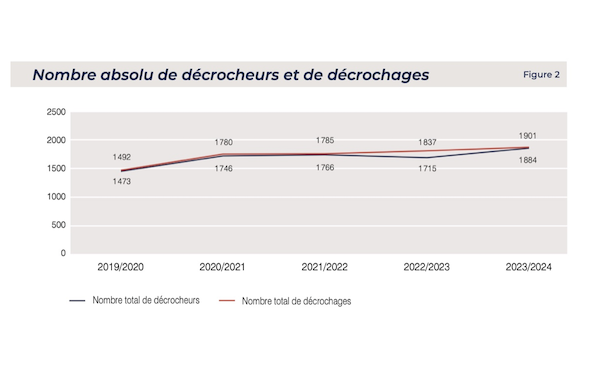 Absolute Number of Dropouts and Dropout Incidents;
Credit: MENEJ
Absolute Number of Dropouts and Dropout Incidents;
Credit: MENEJ
On Thursday 22 May 2025, Luxembourg’s Ministry of Education, Children and Youth published the latest edition of its report “Young Dropouts and Inactive Youth in Luxembourg”, covering school dropout trends from the academic years 2019/2020 to 2023/2024.
According to the ministry, following a decrease of 0.5 percentage points in 2022/2023, the dropout rate rose by 0.6 percentage points in 2023/2024, returning to levels seen in 2020/2021 and 2021/2022. The dropout rate for 2023/2024 stood at 8.2% (1,884 students), compared to 7.6% (1,716 students) in 2022/2023.
The ministry noted the following dropout rate trend over the past five years:
- 2019/2020: 7.0%
- 2020/2021: 8.2%
- 2021/2022: 8.1%
- 2022/2023: 7.6%
- 2023/2024: 8.2%
Nevertheless, Luxembourg continued to meet the European Union’s objective of keeping the school dropout rate below 9% by 2030. The ministry highlighted that Luxembourg also remains below the eurozone average of 9.6% in 2024 (Eurostat, 2025).
The ministry explained that when excluding students who re-enrolled the following academic year, the effective dropout rate for 2023/2024 was 6.3% - comparable to 2020/2021 and 2021/2022.
Effective dropout rates:
- 2019/2020: 5.7%
- 2020/2021: 6.4%
- 2021/2022: 6.7%
- 2022/2023: 5.8%
- 2023/2024: 6.3%
The ministry noted that certain groups of students remain more at risk of dropping out. Although the proportion of female dropouts rose slightly to 39.1% in 2023/2024 (up from 37% the previous year), boys continued to represent the majority. Most students who left school early during the academic year in question had fallen behind by two years (27.5%), a pattern consistent with previous years. The ministry also observed a sustained increase in dropout rates among students in the tenth and eleventh school years (equivalent to 4e and 3e in secondary education and their vocational counterparts). The most commonly cited reasons for leaving school were new educational or career plans; in vocational programmes, the inability to secure an apprenticeship was frequently mentioned.
Students enrolled in pathways leading to a Vocational Aptitude Diploma (Diplôme d’Aptitude Professionnelle - DAP) and those in the upper general secondary track were among the most affected. However, many of these students re-enrolled the following year - 31.6% and 24.8% respectively, demonstrating a willingness to continue their education after a change in direction.
According to the ministry, dropout prevention includes enhanced school guidance, targeted interventions in at-risk classes, extension of compulsory education and support through socio-professional integration centres (CISP). These centres provide alternative schooling that are believed to better meets the needs, abilities and interests of students in difficulty.
Moreover, the ministry reported that the National Youth Service (SNJ) conducted 127 classroom interventions and 241 follow-ups in 2023/2024, targeting at-risk students - especially those in 5e classes transitioning to vocational tracks. The SNJ reached out to a total of 1,736 individuals. The ministry added that SNJ agents systematically contacted all identified dropouts. In 2023/2024, they reached 2,210 young people using monthly lists from the ministry, offering personalised support.
The ministry highlighted that the SNJ also offers practical alternatives for school dropouts and inactive youth. In 2023/2024, 384 young people took part in practical workshops over a twelve-month period, 258 completed internships in companies, and 525 new voluntary service contracts were signed (i.e. 2,830 volunteers).








